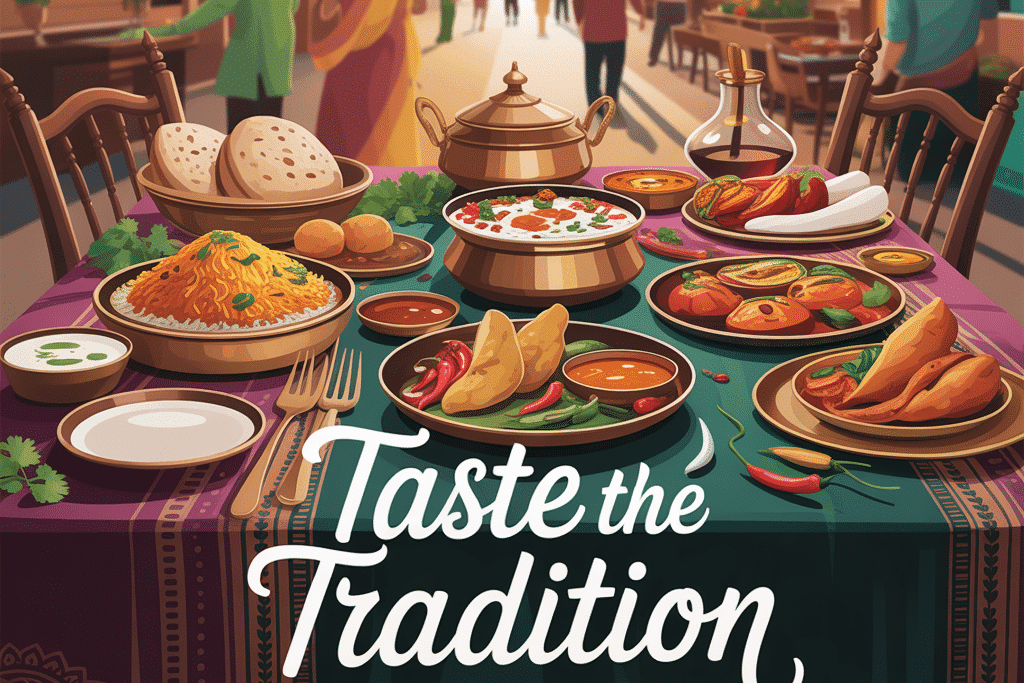Celebrating World Indian Food Day: A Journey Through Flavors, History, and Culture
Indian cuisine is more than just food—it’s a sensory experience that tells stories of heritage, diversity, and tradition. World Indian Food Day is the perfect occasion to celebrate this vibrant culinary legacy that has captivated taste buds around the globe. From rich curries to fragrant biryanis, crispy snacks to delicate sweets, every dish reflects centuries of history and cultural exchange.

The Significance of World Indian Food Day
World Indian Food Day is not just about enjoying a delicious meal; it’s about honoring India’s diverse gastronomic heritage. With over 2,000 distinct ethnic groups and a history influenced by trade, migration, and colonization, India’s food culture is one of the most diverse in the world. Celebrating this day is a way to recognize how Indian cuisine has become a global ambassador for flavor, hospitality, and tradition.
If you’d like to learn more about the cultural and historical importance of Indian cuisine, the Incredible India tourism site offers an excellent overview of the country’s food heritage.
A Mosaic of Regional Delights
India’s geography and cultural variety shape its food in extraordinary ways:
- North India: Known for creamy curries, tandoori dishes, and breads like naan and paratha. Popular dishes include butter chicken, paneer tikka, dal makhani, and rogan josh. BBC Good Food’s Indian recipes are a great starting point for cooking these dishes at home.
- South India: Offers rice-based meals, tangy tamarind flavors, and coconut-infused curries. Favorites include dosa, idli, sambar, rasam, and fish curry.
- East India: Famous for sweets like rasgulla, sandesh, and mishti doi, as well as seafood and mustard-flavored curries.
- West India: Home to spicy street food like vada pav, tangy chaats, and vegetarian delicacies from Gujarat and Rajasthan.
Spices: The Heartbeat of Indian Cooking
The magic of Indian food lies in its masterful use of spices—cumin, turmeric, coriander, cardamom, cinnamon, and cloves. In many households, spice blends (masalas) are prepared fresh for each meal, ensuring maximum flavor and aroma.
To dive deeper into the health benefits of Indian spices, check out Healthline’s guide to Indian spices.
A Rich Culinary History
The story of Indian food is also the story of India itself. Ancient trade routes brought ingredients like chilies (from the Americas), saffron (from Persia), and tea (from China). Mughal emperors introduced biryani and kebabs, blending Persian influences with local spices.
The Smithsonian Magazine’s article on the history of Indian cuisine offers fascinating insights into how these influences merged over centuries.
Indian Food’s Global Influence
From curry houses in London to dosa cafés in New York, Indian food has traveled far beyond its homeland. The popularity of Indian street foods and plant-based curries has surged globally, with chefs fusing Indian flavors into pizza, tacos, and even desserts.
You can explore innovative recipes from around the world on Serious Eats’ Indian food section.
How to Celebrate World Indian Food Day
- Cook an Authentic Recipe: Try your hand at making classics like chole bhature or masala dosa using resources like Sanjeev Kapoor’s official recipe site.
- Explore Street Food: Sample pani puri, samosas, or pav bhaji for a taste of India’s bustling markets.
- Host a Food Night: Invite friends and family to cook together, share stories, and learn about the origins of each dish.
- Support Local Indian Restaurants: Dine in or order takeout to experience authentic flavors while supporting small businesses.
Final Thoughts
World Indian Food Day is more than a celebration of taste—it’s a tribute to India’s cultural richness, regional diversity, and centuries-old traditions. Whether you’re an adventurous foodie or someone discovering Indian flavors for the first time, this day reminds us that food is one of the most powerful ways to connect people across borders.
So, on this special day, fill your plate, share a smile, and let the spices tell their story.
1. What is World Indian Food Day?
World Indian Food Day is an annual celebration of India’s rich and diverse culinary heritage, highlighting traditional dishes, regional flavors, and the cultural history of Indian cuisine.
2. When is World Indian Food Day celebrated?
While there is no official global date, many communities celebrate it in August or during Indian cultural festivals like Diwali or Independence Day events.
3. Why is Indian food famous worldwide?
Indian food is celebrated for its bold flavors, complex spice blends, variety of vegetarian and non-vegetarian options, and deep cultural significance.
4. What are the most popular Indian dishes internationally?
Some globally loved dishes include butter chicken, biryani, samosas, masala dosa, tandoori chicken, and naan bread.
5. Are all Indian dishes spicy?
No. While some dishes are hot and spicy, many are mild, creamy, or subtly flavored, depending on the region and recipe.
6. Is Indian food healthy?
Yes—when prepared traditionally. Many Indian recipes use fresh vegetables, legumes, whole grains, and medicinal spices. However, fried and creamy dishes should be enjoyed in moderation.
7. What makes Indian spices unique?
Indian spices are often roasted and ground fresh, creating complex aromas and flavors. They are also valued for their medicinal benefits in Ayurveda.
8. How can I try authentic Indian food outside India?
Look for family-run Indian restaurants, attend cultural festivals, or try cooking authentic recipes using traditional ingredients from Indian grocery stores.
9. Can Indian cuisine be adapted for vegans or vegetarians?
Absolutely. Many Indian dishes are naturally vegetarian, and dairy can often be substituted with plant-based alternatives like coconut milk or almond yogurt.
10. How can I celebrate World Indian Food Day at home?
Cook a full Indian meal, decorate with colorful fabrics, play Indian music, and share stories about the dishes you’re preparing to immerse yourself in the culture.
